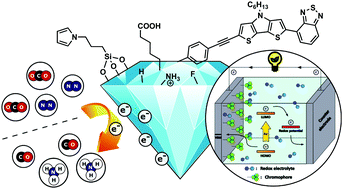Diamond surface functionalization: from gemstone to photoelectrochemical applications
Abstract
Diamond is a highly attractive material for photoelectrochemical applications such as dye-sensitized solar cells or photocatalysis because of its high chemical stability, high conductivity upon doping and the ease by which synthetic diamond thin films or nanostructures can be grown on various substrates. For these applications in particular, a well-defined surface functionalization is a crucial, yet non-trivial matter. In the first part of this review we therefore provide an extensive overview of the surface chemistry of doped and intrinsic diamond thin films. Different techniques to alter the surface termination of freshly grown diamond electrodes are illustrated and compared. Next, the subsequent functionalization steps to form stable covalent bonds between (linker) molecules and the diamond surface are discussed, with special emphasis on photochemical and (electro)chemical diazonium grafting. Several strategies to fabricate macromolecular brushes via surface initiated and direct polymerization techniques are proposed as well. In the second part, the photocurrent generation of dye-sensitized boron-doped diamond electrodes is compared and the influence of the employed chromophores, functionalization strategy, surface contamination and doping concentrations is analyzed. To conclude, the emerging photocatalytic applications of diamond are highlighted, such as the reduction of carbon monoxide, ammonia synthesis and water splitting.

- This article is part of the themed collection: Recent Review Articles


 Please wait while we load your content...
Please wait while we load your content...